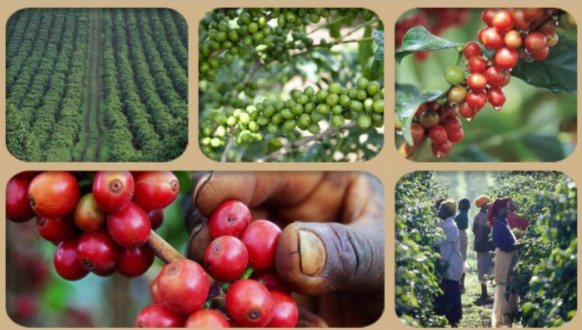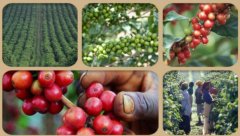General situation of Coffee in Ethiopia Coffee growing Coffee running away from ET Coffee processing Arabica
1. The hometown of Arabica, the source of coffee in the world
The first thing to mention, of course, is that coffee, this amazing guy, actually originated in Ethiopia.
In the world coffee market, the most important high-quality coffee variety, Arabica coffee, ta's hometown is Ethiopia.
It is generally believed that coffee originated in Kaffa, Kafa province, Ethiopia. Coffee is called Bunn, or Buna, in ET, and it is speculated that coffee bean comes from Kaffa Bunn.
In the long history, the nomads in the mountains of ET were the first to discover the awakening effect of this magical plant, although, at first, the nomads did not drink drinks made of coffee beans, as we do today, and they chewed on the flesh of coffee fruits. Or, after the coffee fruit is mashed, it is mixed with animal fat to make food, which acts as an energy bar on the long nomadic journey.
When it comes to the origin of coffee, it is natural to mention that the world-famous name-Kaldi, Cuddy or Caldy, the legend of shepherd Cuddy's discovery of coffee is a strange story that has to be mentioned in many coffee books, and it is needless to say that Cuddy stumbled upon coffee through dancing sheep.
Cuddy's legend has spread so far, how many listeners will believe it? I'm afraid, the spectators are just as an interesting joke, after all, the legend of this thing.
Serious scholars believe that Cadi's legend is fictional on the grounds that Cadi can only be traced back to 1671.
But what does it matter?
People still like coffee as usual, don't they?
two。 Coffee run away from ET
Although it is said that ET is the hometown of coffee, the earliest commercial record of coffee cultivation is in Yemen, Yemen. A. D. 575. HoHo~ calculated in this way, the history of the discovery of ET should also be in the 6th century AD.
We have to go back to our lucky Mr. Cuddy, that is to say, after the magical Cadi discovered the miraculous coffee, he brought it to the equally magical Sufi, who spread the wonderful use of coffee to the whole Middle East. Coffee came to Europe from the Middle East, and then was brought to European affiliates, such as Indonesia and America.
3. Coffee industry
ET has long been one of the top ten coffee producing areas in the world, and is the vanguard of African producing areas.
ET has a federal department, the coffee and tea Authority, that specializes in coffee and tea-related matters, such as setting purchase prices for washing plants.
ET produces a lot of coffee, but unlike other producing countries, the domestic consumption of coffee in ET is also very large, which is very different from many coffee farmers who do not drink coffee only for the economic producing countries. Half of the output of ET contributes to its own citizens. Of course, like other producing countries that rely on coffee to earn foreign exchange, although their citizens are keen on coffee, the best grades are naturally sent to consumer countries that can pay a high price.
There is nothing unique about the flow of ET coffee exports, with half going to the European Union, then the United States, then Japan in Asia, and so on.
Coffee plays an important role in the ET economy and is an important part of GDP. Once half of the foreign exchange came from coffee, and the income brought by coffee accounted for 10% of the government revenue.
4. The cultivation of coffee
Although ET is an established supplier of coffee and has the longest history of coffee, the cultivation of ET coffee is also the most historically handed down. So far, many picking and processing are done entirely by hand. However, this does not mean that coffee farmers lack new knowledge. On the contrary, they are the professional who know best how to get high-quality coffee.
There are numerous ET coffee farms, and there are many small coffee farms. The most well-known producing areas are harar,sidamo (yirgacheffe) and ghimbi.
Although there are not many organically certified coffees in ET, most of them are actually organic products. Yes, coffee in most producing areas is grown in shade, not to mention that many of them are grown in high mountains and sheltered by ancient rainforests, there is no tradition of using chemicals, and chemicals are only used cautiously in some large state-owned farms.
5. The handling of coffee
The traditional method of treatment is solarization. In 1972, the first water washing processing plants were built in the Yirgacheffe production area. Decades ago, most coffee is now wet-processed in the western and southern regions.
In general, wet-processed coffee is thought to be more pure, softer, rounded and better acidity. Dry processing is slightly better in terms of mellowness and richness.
Yirgacheffe is the best wet-processed ET coffee. Although ET coffee, like many African coffee, is famous for its fruit style and red wine flavor, Yirgacheffe's unparalleled high-quality flavor still makes it an insurmountable classic in the boutique coffee world. Dry-processed coffee is often considered to be slightly inferior in flavor, but this conventional wisdom is declared invalid when it comes to dry Harar. Dry Harar, with its wild and mellow performance, has become another peak of ET coffee that can compete with Yirga in the world of boutique coffee.
When it comes to coffee processing, in the tradition of ET, it still follows the ancient method of drying. A coffee senior once mentioned his experience in ET. Even if it is a wild coffee tree, in the harvest season, some people will carefully pick the coffee fruit for follow-up treatment. The elder wrote that when driving on a sparsely populated road, he found coffee fruit drying on the road and was carefully circled. Imagine that scene, is it very kind, only if you really regard coffee as a part of daily life will there be such a practice at home.
Of course, most of the coffee dried directly on the road will not appear in the export ranks, because the treatment is too crude and is mainly used for local consumption or supply to the local market. As for the coffee fruits in the export ranks, they are now carefully handled on high beds off the ground.
Country: Ethiopia
Grade: G2
Producing area: Sidamo producing area
Treatment: washing
Variety: Heirloom
Flavor: wild ginger, honey, citrus, lemon

Important Notice :
前街咖啡 FrontStreet Coffee has moved to new addredd:
FrontStreet Coffee Address: 315,Donghua East Road,GuangZhou
Tel:020 38364473
- Prev

What is the flavor of coffee? the secret recipe of Malaysian tradition is the original three-in-one white coffee.
1. (3-in-1) Nocco Ibao original white coffee is mainly made of high-quality Liberica coffee beans, supplemented by high-quality Arabica and Robusta coffee beans with excellent skim milk powder, natural sucrose and other raw materials. According to Malaysia's traditional secret recipe, caffeine has been largely removed after moderate and mild low temperature baking and special processing.
- Next

Ethiopian Coffee Conger Cooperative Ethiopia Yejia Sheffield Conger Cooperative
Ethiopia Yirgacheffe Konga Cooperative Ethiopian Yejia Sheffield Conger Cooperative: Conger Cooperative (YCFCU member, Yega Sheffield Coffee Farmers Cooperative Union, Yirga Cheffe Coffee Farmers Cooperative Union) member: 2000 Farmer area: Kongo, altitude near Konga,Yirgacheffe: 2100m left
Related
- Detailed explanation of Jadeite planting Land in Panamanian Jadeite Manor introduction to the grading system of Jadeite competitive bidding, Red bid, Green bid and Rose Summer
- Story of Coffee planting in Brenka region of Costa Rica Stonehenge Manor anaerobic heavy honey treatment of flavor mouth
- What's on the barrel of Blue Mountain Coffee beans?
- Can American coffee also pull flowers? How to use hot American style to pull out a good-looking pattern?
- Can you make a cold extract with coffee beans? What is the right proportion for cold-extracted coffee formula?
- Indonesian PWN Gold Mandrine Coffee Origin Features Flavor How to Chong? Mandolin coffee is American.
- A brief introduction to the flavor characteristics of Brazilian yellow bourbon coffee beans
- What is the effect of different water quality on the flavor of cold-extracted coffee? What kind of water is best for brewing coffee?
- Why do you think of Rose Summer whenever you mention Panamanian coffee?
- Introduction to the characteristics of authentic blue mountain coffee bean producing areas? What is the CIB Coffee Authority in Jamaica?

